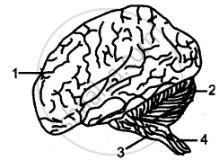Advertisements
Advertisements
प्रश्न
The below diagram represents the human brain as seen in an external view. Study the same and then answer the questions that follow:

(i) Name the parts labeled 1, 2, 3, and 4.
(ii) Mention the difference in the arrangement of the nerve cells in the parts marked ‘1’ and ‘4’.
(iii) What is the main function of the parts marked ‘3’ and ‘4’?
(iv) Name the sheet of nerve fibers that connect the two halves of the part labeled ‘1’.
उत्तर
(i)
1. Cerebrum,
2. Cerebellum,
3. Medulla oblongata,
4. Spinal cord.
(ii)
1. Gray matter is outside and white matter inside.
4. White matter s outside and gray matter is inside.
(iii)
3. Medulla oblongata controls all involuntary movements of internal organs e.g., breathing movements of lungs, beating of the heart.
4. The spinal cord performs reflex action below the neck.
(iv) Corpus callosum.
APPEARS IN
संबंधित प्रश्न
Give any two functions of the cerebrum.
The part of the brain associated with memory.
Differentiate between following pair with reference to the aspect in bracket.
cerebrum and cerebellum (function)
Which part of the brain is involved in processing the following information.
Seeing a picture
The rhombencephalon is also known as ____________.
Which of the following are parts of forebrain?
Forebrain is the centre of human memory.
______ is the controlling center of the body.
The brain is covered by a three-layered tissue covering called ______.
The largest basal nucleus at the floor of the cerebrum is ______.
